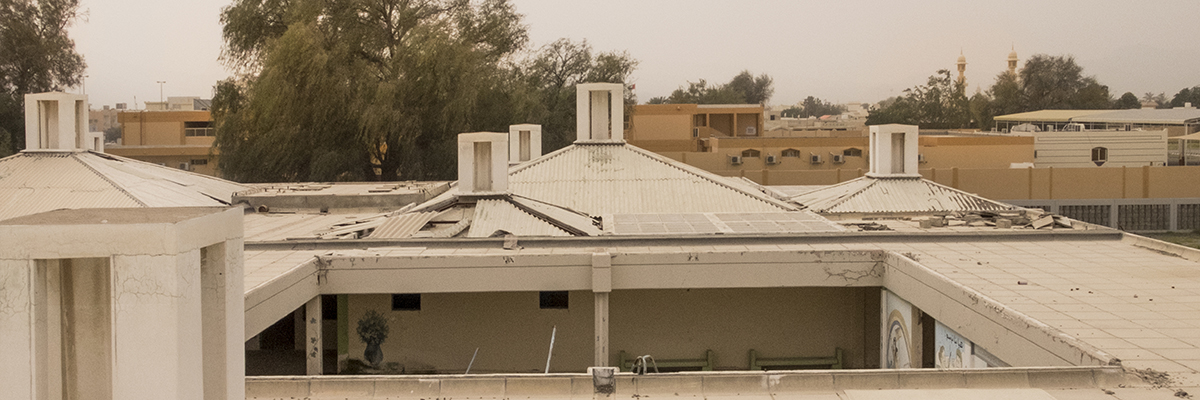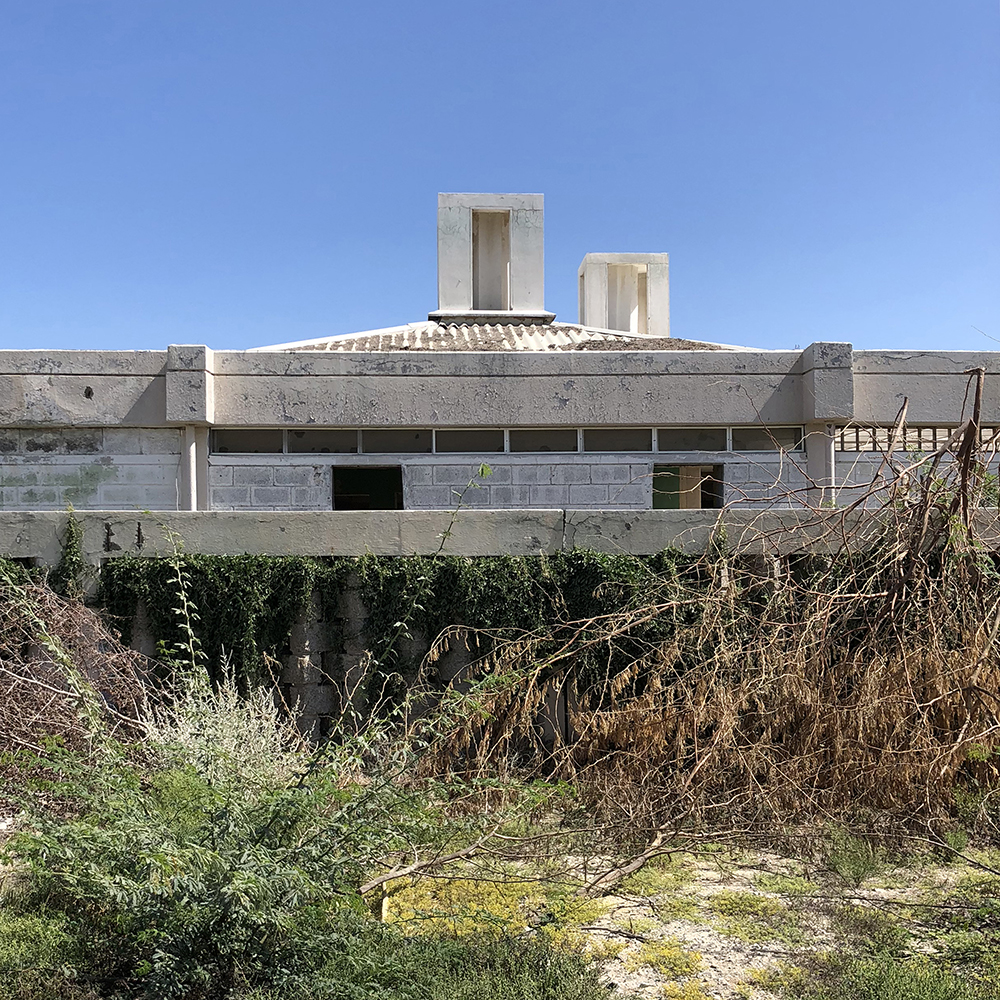

The federation of the United Arab Emirates brought about opportunities for major developments in the young nation. Among the top priorities was to encourage Emirati citizens to seek education in order to lead the country towards a prosperous future. As part of this initiative, the government commissioned the design of prototypes for public kindergartens and schools across the emirates. The first kindergarten prototype incorporated eight classrooms, but eventually a new design was needed in order to accommodate the major increase in student enrolment.
In 1974, an architectural firm based in Beirut was commissioned to design a kindergarten prototype. The firm was run by acclaimed Arab modernist architects Georges Rais and Jafar Tukan. The 12-classroom kindergarten, which accommodated 365 students, provided an intimate environment for students within a cluster typology. It maintained a balance between designated learning spaces and areas of convergence as well as interior and exterior places within each classroom. The design responded to geographical, environmental and cultural contexts with a contemporary lens while maintaining an efficient, sustainable and streamlined process. To provide ventilation and cooling, the distinct pyramidal roofscape integrated a wind tower, resembling in its function the traditional barjeel system.
Tens of kindergartens adhering to this prototype were constructed across the UAE. Some were repurposed; others were demolished. The kindergarten in Kalba, on a vast plot overlooking the Gulf of Oman and with a backdrop of the Hajar Mountains, was the only one in the city for many years, but it was abandoned after a new kindergarten design was conceived. The kindergarten now exists in a derelict condition, but the site has been acquired by Sharjah Art Foundation and will be repurposed as a community centre for the residents of the city.
Since its acquisition by the Foundation, the kindergarten has been the site of Mohamed Bourouissa’s Sharjah Biennial 14 work Blida-Joinville (2018–2019), which brought into conversation the architecture and histories of a psychiatric hospital in Algeria and the school in Kalba. As part of the preparation for Bourouissa’s work, participants in a workshop drew on and coloured the inner walls of the kindergarten with designs of a virtual garden, linking the school to a patient at the Algerian hospital who developed a gardening method as a form of therapy.

In Kalba, a town on the Emirate of Sharjah’s east coast, just north of the UAE border with Oman, stands an abandoned kindergarten that was built in 1979. Scattered across the building’s 12 classrooms is a collage of discarded items coated with a thick layer of dust—books, toys, chairs, building blocks, colouring sheets and chalk. Rusted swings, a slide and a roundabout can still be found in the central courtyard.
Kalba Kindergarten is one of a number of kindergartens built in different locations across the UAE that were based on a 1974 prototype designed by Beirut-based architecture firm Rais and Tukan, a partnership between Lebanese architect George Rais and Palestinian-Jordanian architect Jafar Tukan. Surrounded on its perimeter by a wall of concrete blocks arranged in a woven pattern—with only its distinct pyramidal roofs visible from the street—the 3,254-square-metre building is located on a vast plot of 13,758 square metres. The kindergarten is oriented towards the Gulf of Oman with a backdrop of the Hajar Mountains, which are framed by an opening in the courtyard. When entering the building, the user interacts with the sensitive scale and the fluid sequence of masterfully orchestrated open and closed spaces that accompanied the daily school rituals of children: large open-air courtyards, covered galleries, indoor common spaces, small classrooms and intimate patios. Within the building there is a flow between indoor and outdoor spaces, education time and playtime.
Since the early days of the public education system, the UAE has opted for prototype schemes, which are particularly efficient at meeting the pressing educational needs of the state. Rais and Tukan’s kindergarten model aimed to address the immense wave of student enrolment that followed a government mandate to facilitate and compel access to education with the unification of the Emirates. The 12-classroom design replaced the first kindergarten prototype with only eight classrooms, which was designed by the Ministry of Public Works in collaboration with the Ministry of Education.1 Submitted in 1974, Rais and Tukan’s prototype design was used for over a decade with kindergartens built in Dubai, Ajman and Fujairah. In 1987, it was replaced by a new prototype designed by the Ministry of Public Works, also with 12 classrooms, but this design aimed to present a modernised rounded structure that was believed to be more attractive to children while also facilitating adult supervision.2
Rais and Tukan’s design addresses vernacular architecture reinterpretation and a humanist cluster arrangement and scale. The introverted courtyard scheme is based on the concept of a rationalised one- storey cluster typology, which organises designated learning spaces in relation to centralised common areas of convergence. Serving as an open-air playground, the courtyard is surrounded by a covered loggia that allows for shade and air circulation between the administration block—situated near the
entrance, with a reception and waiting area, director’s room and staffroom—and two educational wings located on each side. The wing entrances are more directly connected by a covered passage that crosses the courtyard and extends into the interiors to delineate the two open clusters that form each wing.


The two wings most likely correspond to the kindergarten’s two educational levels—first year and second year. Though the number of students would vary from one year to the next, the building could accommodate approximately 365 children.3 The floor plan is composed of square modular units with each wing featuring two multipurpose spaces with three classrooms organised around each of them. The weaving of interior and exterior spaces extends to the two wings, with each classroom connected to its own shaded outdoor patio. A variety of furniture configurations can be adopted in the classrooms and multipurpose spaces, suggesting a highly fluid and adaptable scheme. The foldable doors allow the classrooms to be fully enclosed to secure a quiet environment free of distractions or fully opened to the adjacent multipurpose hall, further reinforcing the concept of the scheme adaptability.4 Despite the ceiling height of the interior spaces, the scale and configuration of both classrooms and common halls create an intimate environment. The scheme and its architectural expression seem to fully respond to the aim of encouraging playtime while setting a preparatory tone for the academic system.
Architecturally, the building appears to have been conceived as a solid peripheral enclosure with its unifying horizontal concrete band and a characteristic pyramidal roof scape with an integrated wind tower. The 12 small pyramidal roofs of the classrooms are clustered around the four larger and higher roofs of the multipurpose spaces. A contemporary reinterpretation of barjeel wind towers, the roofing structures integrate a traditional technique of ventilation and cooling into their design. Other sustainable architectural elements include exposed concrete columns, tie beams and roof structures, a double roof with an air gap and infill concrete double walls—maintenance-free materials that ensure insulation.

The kindergartens based on the Rais-Tukan model that were built throughout the UAE have had varying lifespans. Some have been demolished or abandoned; others have been repurposed to fit the context of their site. When constructed in 1979, Kalba Kindergarten was the only kindergarten in the city, and it remained so for many years, but more recently it has been left unused and derelict.5 In 2016, it was acquired by Sharjah Art Foundation, which plans to adapt the space to serve as a community centre for Kalba and its surroundings. Since its acquisition by the Foundation, the kindergarten has been the site of Mohamed Bourouissa’s Sharjah Biennial 14 work Blida-Joinville (2018–2019), which brought into conversation the architecture and histories of a psychiatric hospital in Algeria and the school in Kalba.
Rais and Tukan’s kindergarten prototype recalls innovative approaches to designing educational institutions from the 1960s, such as Aldo van Eyck’s Amsterdam Orphanage and Herman Hertzberger’s Montessori School in Delft. All three projects share a faithfulness to the concept of creating clusters of designated educational spaces that converge into nodes of social activity. They also enrich the modernist conversation by addressing human needs with an attention to scale, circulation and spatial arrangement.
The history of Rais and Tukan’s commission reflects a time when education had assumed a high national priority in the UAE, becoming compulsory for all children over the age of six. Kindergarten education was offered at two levels for children between the ages of four and six in a co-educational setting.
Education was viewed as the force that would stimulate Emirati citizens to take charge of the future of the UAE rather than rely on the expertise of expatriates. Access to public education was free and facilitated with the provision of transportation, stationery, uniforms, a daily meal and a stipend for national students based on their educational level.6
The kindergarten project also echoes an era when regional and international architects were sensitive to the UAE and Gulf context. The regionally acclaimed Rais and Tukan belong to a group of modernist architects and firms that include Victor Bisharat, Rifat Chadirji, The Architects Collaborative, and Page and Broughton, all active in the UAE in the 1970s and early 1980s, who designed and produced culturally and environmentally responsive modern buildings that met the new requests and programmatic needs of the emerging state. Together they succeeded in creating a new architectural identity by reinterpreting and readapting historical architecture typologies and traditional elements, while remaining aware of the international architectural conversations of their epoch.
Endnotes:
1 UAE Ministry of Public Works, Role in Development (1974).
2 Research and Studies Department, UAE Ministry of Education, Education Development in the United Arab Emirates, 1972–2012 (2013).
3 UAE Ministry of Education, Annual Report (1983–1984).
4 Original drawings of the prototype have been retrieved from the archive of the Arab Centre for Architecture, Beirut.
5 UAE Ministry of Public Works and Housing, The Role of the Ministry of Public Works and Housing in National Development (1980).
6 UAE Ministry of Education, Annual Report (1972–1973).